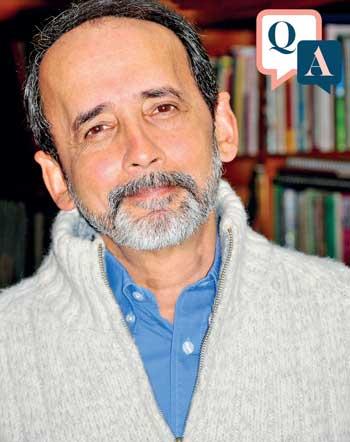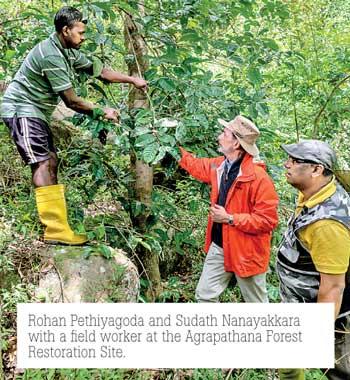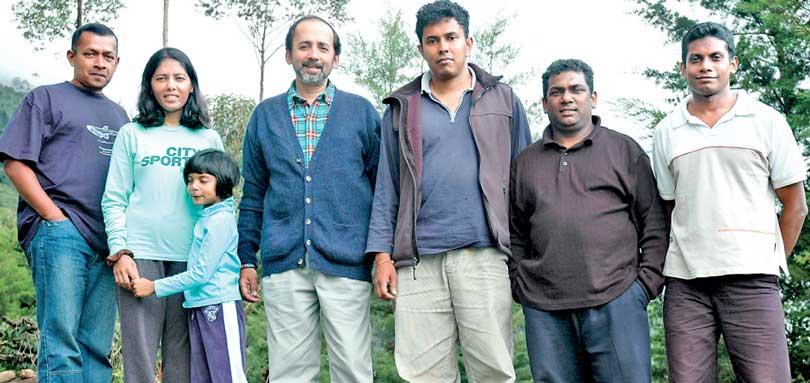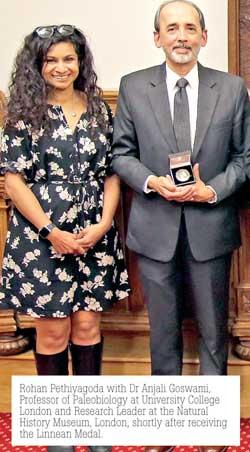 Dr Rohan Pethiydagoda is, without a doubt, a Sri Lankan with a number of remarkable achievements. He was responsible for the discovery and/or description of almost 100 new species of vertebrates from Sri Lanka, has a number of fish and amphibians named after him, has penned a number of books, is a Rolex laureate and most recently, the recipient of the prestigious Linnean Medal. In an interview with the Daily Mirror Life, Dr Pethiyagoda reminisces his life growing up, his career, achievements and his plans for the future.
Dr Rohan Pethiydagoda is, without a doubt, a Sri Lankan with a number of remarkable achievements. He was responsible for the discovery and/or description of almost 100 new species of vertebrates from Sri Lanka, has a number of fish and amphibians named after him, has penned a number of books, is a Rolex laureate and most recently, the recipient of the prestigious Linnean Medal. In an interview with the Daily Mirror Life, Dr Pethiyagoda reminisces his life growing up, his career, achievements and his plans for the future.

Q
What was your life like, growing up?
My father was a tea planter, and for most of my early years we lived in two beautiful plantation bungalows: Bearwell and Tillicoultry, near Lindula. Both these houses were close to the Agra Oya and overlooked the Great Western hills. This was an idyllic landscape in which to grow up. Though a very social man, my father also enjoyed his solitude and was a keen trout fisherman. I never took to fishing, but I did enjoy joining him on these trips to lonely streams that then used to be stocked with trout, in places like Horton Plains. But I did have a deep interest in fishes and maintained a large aquarium which I stocked with species from the local streams and rivers.
We gained a huge amount of knowledge from this project, and this can now be deployed to accelerate other projects in the future
My mother, herself the daughter of a Scottish tea planter, is an archetypal planter’s wife. She maintained several head of cattle, a few hundred chickens and took horticulture very seriously. This gave the family some useful supplementary income. And at 97, she still makes the best jams, chutneys and marmalades in the world. A competent pianist, she also played the harmonium at St John’s Church, Lindula, at the Sunday service. Dating to 1876, this is one of the most beautiful of the up-country churches. She gave me an abiding interest in music, and it is a rare day on which I do not spend at least some minutes, sometimes hours, playing the piano. It is my favorite, and strictly solitary, pastime.
I schooled first at S.Thomas’ Prep and then at Mt Lavinia. My school career was spotty, and I actually failed my O levels the first time I sat them. I was going through a very rough patch. But two wonderful teachers, Paul Beiling and Godfrey Senaratne evidently saw some potential in me and inspired me to take my studies seriously. They opened up the wonderful world of mathematics and physics to me. When I watch episodes of Veritasium on YouTube even now, I often recall the seemingly impossible problems Mr Beiling used to set us in A-level physics and the ease with which he could solve these. If I had to live my life again, I want to be a maths and physics teacher like him.

Q
Tell me about your career progression. You started off as an engineer in the Division of Biomedical Engineering of the Ministry of Health before you eventually shifted to Taxonomy.
When I returned to Sri Lanka in 1980, I found that I was the only biomedical engineer in the country. This allowed my career to progress with extraordinary speed. I was recruited to the Health Ministry and became, at 26, the youngest director in government service. I served under ministers such as Gamani Jayasuriya and Dr Ranjith Atapattu, who were gentleman politicians with standards of ethics and integrity that seem today as if they were from another planet. Being young, I worked like a dog and loved it. I’ve served spells in government ever since. This experience showed me that we have some brilliant, patriotic and truly committed officers in the Administrative Service. I know the public perception of government servants is different, but gosh, it was a pleasure to work with secretaries of the caliber of BC Perera, WM Tillekeratne, Austin Fernando, Thosapala Hewage, M.I.M Rafeek and so many others like them. Absolutely committed, and honourable to a fault.
By 1987, after seven years, I was becoming bored with my job and needed a change. By then, my fishkeeping hobby had become an obsession. I quit and decided to spend a year exploring freshwater fishes. We rented a small house in Nugegoda and I began going around the country collecting fishes and keeping and breeding them in dozens of aquariums scattered around our house and garden. My wife Janaki was very longsuffering about it all and put up with my doings. There wasn’t a book on Sri Lanka’s fishes then, and Rodney Jonklaas, famous for being Archur C. Clarke’s diving guru, encouraged me to write one. This I published in 1991, and it became a hit. It was perhaps the first comprehensive book on the fishes of a tropical country illustrated with colour photographs taken in life.
Q What exactly does the job of a taxonomist entail. What’s a typical day like, for you?
A taxonomist examines organisms and assigns them to species, genera and the like. It is a taxonomist, for example, who decides that despite our morphological diversity, all humans belong to a single species, ‘Homo sapiens’, which is different from our closest evolutionary relative, the chimpanzee, ‘Pan troglodytes’. My day would be spent seated behind a stereomicroscope, examining and measuring specimens, taking photographs and x-rays, doing statistics on the data, and then writing scientific papers. Nowadays, DNA analysis plays an ever-bigger role. I had no biological training at school and so, as with the piano, I was forced to teach myself what I needed to know.

Young people who went on to excel, at the Agrapatana Lab, ca 2001. L-R, Kelum Manamendra-Arachchi, now a lecturer at the Postgraduate Institute of Archaeology, University of Sri Jayewardenepura; Suyama Boyagoda, now Professor of Zoology at the University of Peradeniya; Rohan Pethiyagoda; Madhava Meegaskumbura, now Professor of at Guangxi University, China; Sudath Nanayakkara, manager of the Agra Arboretum since 1998; Kalana Maduwage, Professor of Biochemistry, University of Peradeniya. The photo was taken by Anjana Silva, now Professor in Medical Parasitology, Rajarata University.
Q You were responsible for the discovery and/or description of almost 100 new species of vertebrates from Sri Lanka, including fish, amphibians, and lizards, in addition to 43 species of freshwater crabs. How does the process usually work? How painstaking is the effort?
By the time all this work came to be done, I was working with a large team of bizarrely talented individuals within the framework of the Wildlife Heritage Trust, a foundation I established. We set this up in the highlands, at Agrapatana, and our specimen collection and lab became perhaps the most productive in the country. Kelum Manamendra-Arachchi, Mohammed Bahir, Sudath Nanayakkara, Dinesh Gabadage and I collaborated in almost all of this. But it was the four of them that did most of the fieldwork. Subsequently, we were joined by many others. Our lab was open to anyone, local or foreign, to come and work, and we had some of the world’s most prominent biodiversity scientists working alongside us and sharing knowledge. Looking back, this was Camelot.
Q As much as new species are discovered, there are a number of species that go extinct. What are the numbers like?
It is impossible to ever prove that a species is definitively extinct. Rare species may appear extinct because we do not find them, but you can never be sure that the last individual has died. The fact that we continue to discover species previously unknown to science suggests that many species we think are extinct could still be out there. The botanist Himesh Jayasinghe and the herpetologist Mendis Wickramasinghe, for example, have rediscovered species that had not been seen for over a century and were thought to be extinct. So, there is still hope that others will be rediscovered. But as we lose our forest cover, it is certain that more extinctions will occur in Sri Lanka. And in many cases, species will become extinct even before we have discovered them. This is the tragedy of our age.
Dr Rohan Pethiydagoda is, without a doubt, a Sri Lankan with a number of remarkable achievements. He was responsible for the discovery and/or description of almost 100 new species of vertebrates from Sri Lanka, has a number of fish and amphibians named after him, has penned a number of books, is a Rolex laureate and most recently, the recipient of the prestigious Linnean Medal.
Q In 2020 an international team of scientists named a new genus of diminutive Asian treefrogs in your honour. But you have, in fact, quite a number of fish and amphibians named after you. How did it feel when you heard about it?
It is an honour, of course, to have a species or genus named after you. The names of species endure forever and having one named after you seems to give you the illusion of some kind of immortality. But these little ‘honours’ are routine in taxonomy: it is a way of showing appreciation to colleagues or people we admire. In a paper we wrote in 2012, for example, we named a genus of fish for the evolutionary biologist and prominent anti-religionist Richard Dawkins. Despite his celebrity, he told me this was unlike any other honour he had received.
Q You were recently awarded the Linnean Medal, and you are also the first Sri Lankan to be awarded this.
Frankly, I still have no idea how I was selected for this. I have since learned of the scientists who kindly nominated me, but it came as a total surprise. The medal has been awarded annually to recognize the lifetime contribution of a scientist, every year since 1888, so of course I was very pleased to get the news. I was moved almost to choking up when I received the medal on 24 May, in the same hall that Darwin’s theory of evolution by natural selection was first announced to the world in 1861. I was perhaps unique among recipients in the last century in that I have no PhD, or even a Bachelor’s Degree in Biology. And the response here in Sri Lanka has been so wonderful: hundreds of people have sent messages of congratulation and good wishes. I guess that in these dark days, a little positive news was welcome.

Q
You are also a Rolex laureate. You received this honour in 2000 for converting abandoned
tea plantations into natural forests. This project is ongoing?
Yes, the project is still on-going, now in its 24th year, but now under the stewardship of Mr Rajaseelan Gnanam and his family. My idea then, in addition to locating my lab there, went something like this: Sri Lanka’s economy was growing rapidly. In other tea-growing countries, like Taiwan, South Kora and Japan, the tea industries shrank as more and more young people went into cities to work. This was happening in Sri Lanka too. Ever-better educated youngsters prefer to work in a hotel, a bank or a supermarket, or drive a cab or tuk. As tea plantations come to be abandoned, I thought opportunities would arise to turn these back into forest. But how? Our project was aimed at developing affordable methods to rewild abandoned tea estates. We gained a huge amount of knowledge from this project, and this can now be deployed to accelerate other projects in the future. One such has emerged at Udaweriya Estate, for example, which borders Horton Plains. But I didn’t foresee the present economic collapse then. Many more people will return to agriculture now, given the food shortages, and rewilding initiatives will have to be postponed for another generation, at least.
Q What would you say is your proudest achievement to date?
Without a doubt, it is the young people I have in some way helped or inspired over the years. I watch them growing into productive, exceptional scientists and citizens in many ways like a proud father. They are like oxygen for me, and every one of them is much cleverer, more talented and dedicated than I am. I’m not saying this out of modesty: it is just true. If you want to get a feel for what’s out there, take a few minutes to watch one of the short YouTube videos on marine biology by a little girl called Tashini Alosha, from Alawatogoda, near Matale. You can find these by searching for “My Kids Lab Alosha”. She’s so talented and infectiously enthusiastic that when I watch these, I just feel like giving up science and going back to engineering.
Q What’s next for you?
I have some writing planned for the coming year, but given the country’s economic collapse, I think my primary focus will be on helping in any way I can to help get some projects underway. My main worry is about the nutritional status of children whose families will be driven into poverty. Even before the crisis, we had some of the worst statistics in Asia for undernutrition, anemia, wasting, stunting and so on. These in turn lead to poor life outcomes, including reduced intelligence. Given that it will take a decade or more for the country to return to anything like 2019, we have to do all we can to nurture the 3 million kids who are now zero to twelve years old. If there’s anything I lie awake at night thinking about, it is this. Food shortages and costs are precipitating a child-nutrition emergency in Sri Lanka, and we have to do all we can to mobilize assistance before irreparable harm is done.
Pix courtesy: Rohan Pethiyagoda
 Dr Rohan Pethiydagoda is, without a doubt, a Sri Lankan with a number of remarkable achievements. He was responsible for the discovery and/or description of almost 100 new species of vertebrates from Sri Lanka, has a number of fish and amphibians named after him, has penned a number of books, is a Rolex laureate and most recently, the recipient of the prestigious Linnean Medal. In an interview with the Daily Mirror Life, Dr Pethiyagoda reminisces his life growing up, his career, achievements and his plans for the future.
Dr Rohan Pethiydagoda is, without a doubt, a Sri Lankan with a number of remarkable achievements. He was responsible for the discovery and/or description of almost 100 new species of vertebrates from Sri Lanka, has a number of fish and amphibians named after him, has penned a number of books, is a Rolex laureate and most recently, the recipient of the prestigious Linnean Medal. In an interview with the Daily Mirror Life, Dr Pethiyagoda reminisces his life growing up, his career, achievements and his plans for the future.  Q What was your life like, growing up?
Q What was your life like, growing up? Q Tell me about your career progression. You started off as an engineer in the Division of Biomedical Engineering of the Ministry of Health before you eventually shifted to Taxonomy.
Q Tell me about your career progression. You started off as an engineer in the Division of Biomedical Engineering of the Ministry of Health before you eventually shifted to Taxonomy.
 Q You are also a Rolex laureate. You received this honour in 2000 for converting abandoned
Q You are also a Rolex laureate. You received this honour in 2000 for converting abandoned